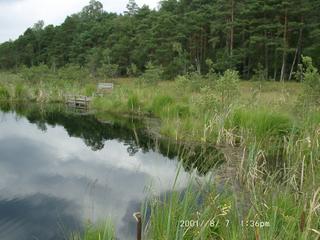About Forests upon Upper Liswarta River
like to tell to you bit more about a Nature Park where
I do my research. As you could see on a map in my entry here from 21st. July 2005 I live on the border of one of Nature Parks within Silesian Voivodeship. Now look on your right above at another map of the Park to find out something more about its area. With 3 black rings I have marked areas of two peatbogs that occur within the Park and are really interesting both from botanical point of view and for nature lovers. The last and biggest ring marks my home town.
Now I am going to present to you three pictures taken at these two peatbogs. First is taken in the peatbog situated further to the eastern border of the Park, second and third picture are taken in the peatbog that has benches around so you can rest there or if you have a fishing rod and special permission you can try to catch there quite nice dinner for you and your family. Now I am going to write bit more about functions and values of peatbogs cause I do think everyone should know something more about this subject.
Their role as a carbon sink has gained visibility recently because of its impact on the greenhouse effect and climate change. Natural peatlands emit greenhouse gases such as methane but they also stock a large amount of carbon present in plant debris and peat. Following drainage and extraction, peat is exposed to air and decomposition processes cause the emission of carbon dioxide thus contributing to greenhouse gas build-up in the atmosphere.
Biodiversity is another value that gives special status to peatlands. Since they are unique, acidic ecosystems, peat bogs support specific plant communities. A number of plant and bird species are found only in peatlands. Recent studies suggest that large peat bogs have a higher value because they have a greater variety of habitats such as pools, and hence, a larger number of species.I will write more about flora of the two small peatbogs that occur within area of this particular Nature Park soon.
Peat bogs also play a role in regulating water flow: by stocking water, peat bogs act as buffers, in case of abundant precipitation. The importance of this role appears when peatlands are lost or drained: water that would normally be stocked reaches watercourses more rapidly, thus contributing to higher peak flow.
Peatlands are also used by many people for recreational uses such as fruit picking and hunting (look at the benches on a picture of another peatbog within Nature Park "Forests upon Upper Liswarta River" on your right above- that you can reach by crossing specially constructed wooden foot-bridge without any fear of sinking into the deep, cold water that is under a layer of spongy mossess - look at the photo of this footbridge on your left below ).
Peatlands are also used by many people for recreational uses such as fruit picking and hunting (look at the benches on a picture of another peatbog within Nature Park "Forests upon Upper Liswarta River" on your right above- that you can reach by crossing specially constructed wooden foot-bridge without any fear of sinking into the deep, cold water that is under a layer of spongy mossess - look at the photo of this footbridge on your left below ).

Their aesthetic and educational values are also recognized since more people have access to nature interpretation trails, especially in parks.
The function of peatlands as paleo-archives is well known by scientists. Because of the low rate of decomposition and anoxic conditions, many plant parts, especially seeds and pollen, are preserved in peat for thousands of years. With modern techniques of dating the age of organic matter, it is possible to reconstruct past environment and climate through the identification of seeds and pollen present within the superposed peat layers. Thus I have presented the most important functions of peatbogs.
The function of peatlands as paleo-archives is well known by scientists. Because of the low rate of decomposition and anoxic conditions, many plant parts, especially seeds and pollen, are preserved in peat for thousands of years. With modern techniques of dating the age of organic matter, it is possible to reconstruct past environment and climate through the identification of seeds and pollen present within the superposed peat layers. Thus I have presented the most important functions of peatbogs.
Of course they also produce peat. I hope everyone knows it:)




Komentarze (0):
Prześlij komentarz
Subskrybuj Komentarze do posta [Atom]
<< Strona główna